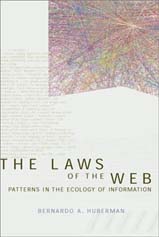| |
The Silverfish is published quarterly by the students
of the Information School at the University of Washington.

About
The Silverfish
Archive
Current
Issue
Editorial
Board
Information
for Authors
Request
Silverfish by Email

|
Book Review: Huberman,
Bernardo A. (2001). The Laws of the Web: Patterns in the Ecology of Information.
MIT Press; ISBN: 0262083035
By Robert Malesko
January 19, 2002
 Bernardo
A. Huberman, in the 2001 MIT Press release The Laws of The Web: Patterns
in the Ecology of Information tries to explain fundamental patterns that
have so far been noticed in web research. Much of this work deals with
complex mathematical formulas and notation, for example the following
equation: Bernardo
A. Huberman, in the 2001 MIT Press release The Laws of The Web: Patterns
in the Ecology of Information tries to explain fundamental patterns that
have so far been noticed in web research. Much of this work deals with
complex mathematical formulas and notation, for example the following
equation:
ß
1 / n where ß = 1
To translate this, and other logical ideas from area-specific language
into plain English he uses simple examples, like the statistical samples
that show that on the web there are many small pages, and proportionally
fewer large sites. (This relationship, and a few others, is the concept
expressed by the above equation.)
Further studies that show Internet congestion comes and goes in patterns
of waves similar to those found proportions of sites. In practical terms
his work may save for an individual precious seconds downloading time
if one reloads a slow moving page approximately as frequently as one notes
a delay-the congestion will soon pass!
He keeps the tone and style light, but a brief mention of the game Six
Degrees of Kevin Bacon is about as entertaining as it gets. The discussion
goes only as deep as that of one formula can for such a disparate group
of study foci; these laws of the internet cannot yet accurately predict
what one individual-or even a small world-will accomplish contextually
through time. While the studies Huberman draws on make available general
patterns of use, these are trends that show over time, and with a great
number of instances. It does not serve to predict what an individual's
next click will be, or how long it will take.
It will, on the other hand, give a reader a sense of what kind of mileage
one can expect; let you know that what statistics are average, and for
comparison, what is outside the norm. The simplicity of this analytical
tool may easily draw premature dismissal. Though Huberman discusses only
three main cases, one could as easily discuss as many more.
The versatility of this model cannot be entirely attributed to Huberman;
he did, after all, use a similar approach as has already been tried (and
found useful) in statistical mechanics. In exchange, though, he saves
the reader the trouble of familiarizing themselves with that particular
field if they already aren't.
This book serves well enough as a brief and readable introduction to the
concepts encountered in studying web behavior.
Submissions
Requested
Would you like to see your book review here? We would
love to hear from you! Send your ideas for Silverfish submissions to Ariel Johnson or John
Buell.
Edited by Ariel
Johnson and John W.N. Buell
Silverfish Web Design by John
W.N. Buell
|


 Bernardo
A. Huberman, in the 2001 MIT Press release The Laws of The Web: Patterns
in the Ecology of Information tries to explain fundamental patterns that
have so far been noticed in web research. Much of this work deals with
complex mathematical formulas and notation, for example the following
equation:
Bernardo
A. Huberman, in the 2001 MIT Press release The Laws of The Web: Patterns
in the Ecology of Information tries to explain fundamental patterns that
have so far been noticed in web research. Much of this work deals with
complex mathematical formulas and notation, for example the following
equation: